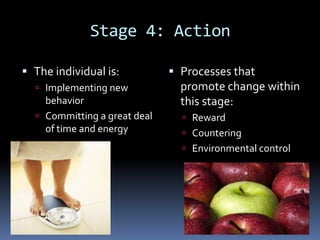Understanding the True Stages of Change for Building a Healthy Lifestyle

Introduction: Why Knowing the Stages of Change Matters
Many people want to live healthier lives, but lasting change rarely happens overnight. Understanding the true stages of change can help you (or those you support) make gradual, sustainable improvements. This article explains the proven stages of change model, real-world examples, and how to apply these principles to your own journey for a healthier lifestyle.
The Five Core Stages of Change Model
The most widely accepted model explaining how people adopt healthier behaviors is called the Stages of Change Model, or
Transtheoretical Model
. This framework is supported by decades of research and has been used in nutrition, exercise, smoking cessation, and more
[1]
[2]
. The five key stages are:
- Precontemplation : Not yet considering change; may not even be aware of a problem.
- Contemplation : Aware that change might be needed; weighing pros and cons, but no commitment yet.
- Preparation : Ready to change; making small plans or steps toward action.
- Action : Actively making changes, such as adjusting diet or increasing physical activity.
- Maintenance : Sustaining new behaviors and working to prevent relapse.
Some models also include a sixth stage, Termination , where the new behavior is fully integrated and there’s no desire to return to old habits [1] .
What’s True About the Stages of Change?
The most accurate and evidence-based statement is: People move through a series of stages-precontemplation, contemplation, preparation, action, and maintenance-when making sustainable lifestyle changes. Each stage comes with its own challenges, motivations, and solutions. Recognizing which stage you (or someone you support) are in can help you choose the right strategies and set realistic expectations [3] .
Stage-by-Stage Breakdown with Practical Guidance
1. Precontemplation: No Intention to Change
In this stage, individuals may not realize their habits are unhealthy or simply aren’t interested in changing. For example, someone might not see an issue with their current food choices or lack of exercise. If you’re supporting someone in this stage, focus on gentle awareness and non-judgmental conversations rather than pushing for change.
Example: A person eats fast food daily and feels no need to switch to healthier options.
Steps: Offer factual information, share personal stories, or suggest a routine health checkup as a starting point.
Challenges: Resistance or denial is common. Patience is essential, as it can take months or years to progress.

Source: slideshare.net
2. Contemplation: Considering a Change
Here, individuals begin to weigh the benefits and drawbacks of their current lifestyle. They might think about the health risks of poor eating or the benefits of regular activity but haven’t committed to action yet [4] .
Example: Someone starts to think, “Maybe I should eat more vegetables, but I’m worried about the cost and prep time.”
Steps: Encourage listing the pros and cons. Suggest simple, low-cost changes, like adding one fruit per day.
Challenges: Ambivalence and procrastination. Motivation can be boosted by focusing on small, achievable benefits.
3. Preparation: Ready to Act
At this stage, people are planning steps and may have made minor changes already. They might buy healthier groceries, research workout options, or seek advice from professionals.
Example: A person signs up for a healthy meal kit or downloads a fitness app.
Steps: Set concrete goals (e.g., “I’ll walk 15 minutes daily”), prepare shopping lists, and create reminders.
Challenges: Overplanning without follow-through. It helps to set a start date and track progress.
4. Action: Making the Change
This is when new behaviors are put into practice. For example, someone starts eating more vegetables, cooks at home more often, or joins a gym. Evidence shows it takes at least three to six months of consistent action for these changes to take hold [5] .
Example: A person increases physical activity, replacing snacks with fruit and preparing meals in advance.
Steps: Keep a journal, celebrate small successes, and seek social support. Consider group programs or coaching for accountability.
Challenges: Setbacks are normal-use them as learning opportunities, not reasons to quit.
5. Maintenance: Sustaining Healthy Habits
In this phase, the focus shifts to preventing relapse and making healthy behaviors a long-term routine. People may still slip up but are generally able to return to healthy habits quickly.
Example: After six months of healthy eating and regular exercise, a person feels confident and starts to enjoy the benefits, such as more energy and better mood.
Steps: Plan for holidays, vacations, and stressful periods. Keep healthy foods on hand, schedule workouts, and practice self-compassion.
Challenges: Life changes can trigger relapse. Prepare by identifying high-risk situations and having a plan to get back on track.
Overcoming Common Challenges at Each Stage
Relapse or setbacks are a normal part of the change process-not a failure. The key is to avoid self-blame and return to the action or preparation stage as needed [2] .
Tips for Success:
- Build self-efficacy: Confidence is a crucial driver of lasting change.
- Seek support: Family, friends, or professional coaching can offer motivation and accountability.
- Set realistic, incremental goals: Focus on one change at a time to avoid overwhelm.
Alternative Approaches and Additional Resources
While the five-stage model is the most common, some programs add a “Relapse” or “Termination” stage. Others incorporate motivational interviewing, cognitive-behavioral strategies, or habit tracking tools. You can find support by searching for “wellness coaching”, “nutritionist near me”, or by contacting your local health department or primary care provider for guidance on accredited programs.

Source: slidetodoc.com
If you are interested in professional help, consider reaching out to registered dietitians through national health associations or certified fitness trainers. Many community health centers offer lifestyle programs for free or at low cost-search for “community health center lifestyle change programs” in your area.
How to Get Started on Your Own Healthy Lifestyle Change
Step 1: Identify which stage you are in using the descriptions above. Step 2: Set a single, specific goal (e.g., “I’ll walk 10 minutes every day after lunch”). Step 3: Track your progress with a journal or smartphone app. Step 4: Seek social support from friends, family, or professionals. Step 5: Celebrate small victories and be patient with setbacks.
For more personalized guidance, ask your healthcare provider about evidence-based lifestyle change resources or group programs in your area.
Conclusion: The Truth About Change
Lasting healthy lifestyle change is a journey, not a single event. The five-stage model is a proven, research-backed approach for understanding and guiding the change process. By recognizing which stage you’re in, using practical strategies, and being patient with yourself, you can make meaningful progress toward a healthier life.
References
- Rural Health Information Hub (2025). Stages of Change Model (Transtheoretical Model).
- MCGC Nutrition (n.d.). Nutrition for a Lifetime: the 5 Stages of Change Model for Healthy Living.
- Kemin Human Nutrition (n.d.). Five Stages for Developing a Healthy Habit.
- LifeSpring Home Nutrition (2024). Nutrition’s Fundamental Role in the 5 Stages of Change.
- National Center for Biotechnology Information (2016). Stage of Change and Motivation to a Healthier Lifestyle.






